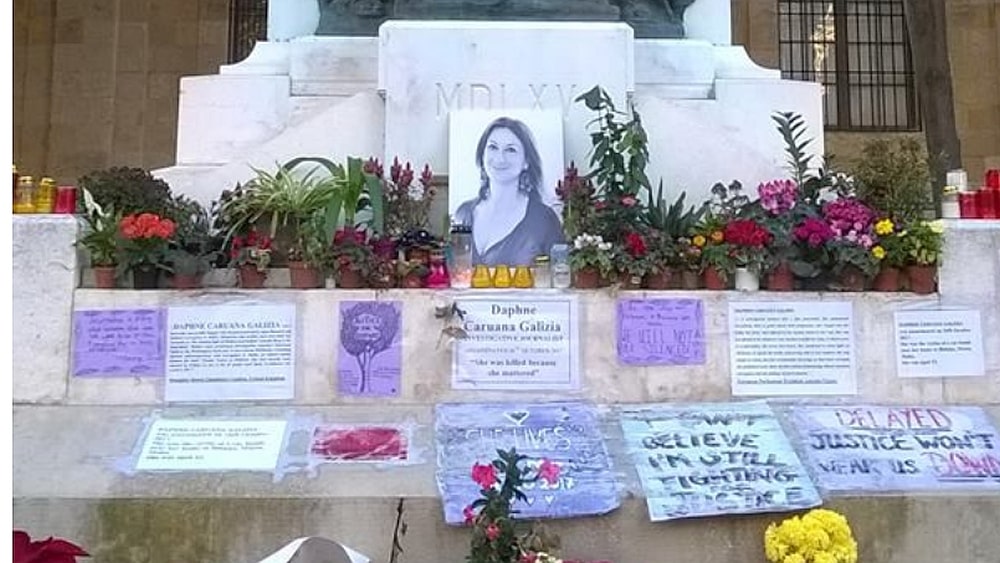 photo by Małgorzata Dwornik
photo by Małgorzata Dwornik[UPDATE: June 12, 2025]
She wasn’t trained in journalism when she first stepped into a newsroom. Nor did she belong to any professional guild, protective editorial board, or old boys’ club. And yet Daphne Caruana Galizia quickly became the most feared writer in Malta - and its most silenced. What she lacked in institutional backing, she made up for with grit, discipline, and an uncompromising belief in public accountability.
Her story didn’t begin with a scandal. It began with disobedience. At 18, she was arrested for joining a protest outside parliament. It wasn’t her last encounter with the law - or with those in power who’d rather not be asked uncomfortable questions. One of the officers who booked her that day would later become a political target of her investigations. She remembered names. So did they.
Born on August 26, 1964, in Sliema, she grew up in a business family and studied in religious schools. But her sense of justice didn’t come from prayer. It came from watching how systems worked - and who they failed. In the 1990s, she enrolled at the University of Malta and earned a degree in anthropology. She was already writing by then. Studying people simply gave her more language to describe what she saw.
Breaking into the boys’ world
Journalism in Malta was a man’s game. Daphne joined it in 1987, writing for The Sunday Times of Malta, one of the country’s most respected dailies. She covered general news at first - safe topics, nothing explosive. But routine didn’t satisfy her. She wasn’t interested in rewriting press releases or quoting ministers. She wanted to ask questions that others avoided.
After her third son was born, she turned to column writing. The format suited her. It gave space for analysis, commentary, and personal voice. By the early 1990s, she had established herself as a powerful columnist - though her sharp tone led some to assume she couldn’t possibly be the real author. Still, readers kept coming. And politicians grew nervous.
Between 1990 and 1992, she focused heavily on the Labour Party, dissecting internal corruption and abuses of office. Her reporting on figures like Lorry Sant - a minister mired in controversy - revealed a depth of research unusual for columns at the time. She wasn’t just venting. She was investigating. And that changed everything.
No allegiance but the public’s
Daphne didn’t follow a party line. She supported the Greens when their environmental proposals made sense. She wrote critically about Prime Minister Fenech Adami and praised him when she thought he deserved it. Her loyalty was to the truth - as she saw it - not to ideologies or alliances. This made her both influential and isolated. The more she wrote, the more pressure she faced.
In the mid-1990s, threats became personal. Her family dog was killed and left at her door. Later, her home was set on fire. She received anonymous letters and threatening calls. Her response was not retreat but escalation. She doubled down on her investigations, searching archives and old case files, unearthing what others had buried.
One of her most significant decisions came in 1996. After the editor-in-chief at The Times of Malta refused to run one of her exposés - involving Guido de Marco, a future president - she resigned. She joined The Malta Independent, where she stayed for the rest of her career. There, she published stories others wouldn’t touch.
Reporting with a second voice
Not everything she wrote was about corruption. In 2004, she launched Taste, a lifestyle magazine focused on Maltese culture, food, design, and travel. It was polished and visually elegant - a break from the often dark, combative world of politics. Friends admired her ability to juggle both projects. At a time when she faced attacks and arson, she still found joy in describing a flower arrangement or a traditional dish.
Yet even Taste carried her signature editorial control. She ran it as editor-in-chief and shaped its tone. In 2014, it merged with Flair and became a weekend supplement to The Malta Independent. Later, it evolved into Taste & Flair, a monthly publication that still exists today. The Daphne Caruana Galizia Foundation now oversees its release.
Through this creative outlet, she showed that journalism didn’t always have to expose wrongdoing to have value. But when it did, she believed it had to be fearless. Behind the elegance of Taste lived the same uncompromising mind that had once stared down ministers, lawyers, and police.
Targeted for persistence
By the time most people start protecting their reputation, Daphne had already given hers away in exchange for impact. She was no longer simply reporting on Malta’s political elite - she was naming them, quoting their lies, exposing their families, and refusing to stop. With every column, she became more divisive, more popular, and more endangered.
It wasn’t just politicians who took notice. In 1996, after a series of particularly critical pieces, her enemies escalated. First came the mutilated dog left on her doorstep. Then her front door was set alight. Anonymous letters and phone threats followed. These weren’t metaphorical attacks on her work. They were physical, calculated warnings. But she didn’t retreat. Her priority became not just writing the truth but protecting the people she loved while doing it.
Daphne understood she was not invincible. But she also understood that silence gave more power to those who used fear as a tool. Her husband, Peter Caruana Galizia, supported her decisions, even when the risks multiplied. She installed safety measures at home, talked to her sons about threats, and prepared for the worst. Still, she kept publishing - digging into past scandals, unearthing old secrets, and following trails no one else dared touch.
The attack that almost worked
Ten years before her death, in 2006, someone tried to kill her. In the early morning hours, gasoline-soaked tires were stacked behind her home and set on fire. The explosion damaged the house. If not for her youngest son coming home late, the entire family might have died in the flames. The story made local headlines - but there were no arrests. No one claimed responsibility. Daphne barely mentioned it in public.
Soon after, another bomb was placed under a car that looked just like hers. It was her neighbor’s vehicle. This time, no one died. But two of the family’s dogs did - poisoned or injured in the chaos. The attacks were close, persistent, and intentional. She knew she had become a symbol, and some people wanted that symbol destroyed.
Instead of going underground, Daphne went online. In March 2008, she launched Running Commentary, a blog that would soon reach almost half a million readers. The first post - “Zero tolerance for corruption” - was aimed directly at Labour leader Alfred Sant. Readers flooded the site with praise and comments. A few days later, she took aim at a familiar name: Anglu Farrugia, the same man who had arrested her as a teenager. Their conflict had come full circle.
Running Commentary. A battlefield of The Witch
With Running Commentary, Daphne no longer needed a newsroom. She didn’t need approval from an editor or the backing of a newspaper. She wrote what she wanted, when she wanted, and people listened. It was Malta’s most popular blog - at times, its most feared. Politicians, business owners, and officials knew that a single post from her could trigger investigations or destroy reputations.
She documented corruption in public contracts, exposed ties between politicians and criminals, and investigated possible cases of money laundering. Her targets weren’t limited to any one party. She criticized Labour and Nationalist politicians alike. She wrote about judges, police commissioners, and even clergy. The more she published, the more powerful the blog became - and the more people wanted her silenced.
Her writing style was unapologetically sharp. She didn’t pretend to be neutral. She made moral judgments, questioned motives, and used sarcasm as a rhetorical weapon. Many saw her as brave. Others called her reckless. Either way, she was read - obsessively - by those in power and by those trying to understand it.
Some called her a witch - not for casting spells, but for exposing secrets. The label stuck, whispered in interviews, shouted in court corridors, scrawled online. It was easier to demonize her than to refute her facts. Her sharp tone and direct language broke with the conventions expected of women in public life. What they couldn`t control, they tried to curse.
When journalism becomes defense
Over the years, Daphne’s work became something more than journalism. It became a form of resistance. In a country where institutions often failed to hold power accountable, she became the substitute. Alone, unpaid, and often sued, she continued to ask questions that others refused to ask. She wasn’t just informing the public. She was defending it.
As her influence grew, so did her legal troubles. Politicians began using libel laws against her. At the time of her death, she had over 40 pending lawsuits. Some were filed by government officials. Others came from businessmen or police. For Daphne, the lawsuits weren’t about money - they were about time and exhaustion. Still, she appeared in court, answered questions, and kept writing.
In between these battles, she found ways to write about lighter subjects. She returned to Taste & Flair, editing and writing with the same discipline she brought to her blog. There, she explored beauty, tradition, and creativity. Friends say this duality - fierce investigator and tender cultural editor - defined her strength. She could live in two worlds at once, without ever losing herself in either.
Digging deeper than anyone dared
Daphne Caruana Galizia was not content to merely echo headlines. She went after the stories others avoided - the ones buried in parliamentary records, offshore accounts, and old court transcripts. Her method was not fast. It was persistent. She knew that political corruption didn’t happen in press releases; it happened quietly, on the margins of legality, under layers of bureaucracy and complicity.
By the late 2000s, Daphne had become Malta’s most relentless watchdog. She revisited closed cases and scrutinized overlooked patterns. She didn`t chase scandals. She tracked systems. She noticed when certain businesses always won government contracts. She saw how key appointments connected back to party donors. She didn’t just name the actors - she mapped their networks.
Her blog wasn’t simply a mirror to Maltese politics. It was a challenge to it. She described herself not as a reporter, but as someone who “fired to kill”. This wasn’t a metaphor for violence - it was a stance against spin. She refused to soften the truth, even when it brought her lawsuits, threats, and isolation. She often wrote alone, at home, without legal protection or editorial support. But she saw this distance as a kind of freedom.
The woman behind the byline
The public knew her voice - strong, witty, and sharp-edged. But behind the scenes, Daphne was also a mother, a wife, and a meticulous researcher. She worked long hours, sometimes starting before dawn, fueled by black coffee and stubbornness. Her home in Bidnija, surrounded by olive trees and fields, was her newsroom, courtroom, and safe house all at once.
She worried constantly about her family. Every threat, every fire, every anonymous letter forced her to think not only as a journalist but as a parent. Her sons grew up in a house where danger came with the morning paper. And yet they also grew up with a model of what it means to speak up when silence feels safer.
Friends described her as warm and loyal, someone who loved conversation, cooking, and the beauty of her country. Even in her harshest critiques, there was a sense of mourning - a deep sadness about what Malta could be, but wasn’t. Her work in Taste & Flair revealed that other side: the one that celebrated light and detail, history and care. She believed in Malta. That’s what made her criticism feel so personal.
A one-woman institution
Between 2008 and 2017, Daphne’s blog became a cornerstone of public discourse. She published new posts almost daily. Each entry was laced with irony, references to local history, and careful documentation. She didn’t rely on leaks. She preferred facts, documents, and patterns of behavior. She built cases, then let readers draw their own conclusions.
Her readership extended far beyond Malta. English-speaking audiences across Europe and beyond followed her writing. She was invited to international conferences, cited by foreign journalists, and recognized as a rare voice of independent scrutiny. But recognition didn’t translate into protection. In Malta, she was still seen by many as an agitator - or worse, a traitor.

She was accused of bias, of vendettas, of destabilizing democracy. Some said she exaggerated. Others dismissed her as elitist. The truth is that Daphne wrote in a tone most reporters didn’t dare adopt - not because it was wrong, but because it required total independence. And independence, in a small country where everyone knows everyone, came at a cost.
Facing the backlash
In the final years of her life, the attacks intensified. Politicians condemned her publicly. Lawsuits piled up. At one point, her bank accounts were frozen, a move she described as institutional harassment. She wrote through it all. Her blog became not only a platform but a record - a daily archive of Malta’s democratic erosion, built post by post.
In 2016, she began working on the Panama Papers leak. She identified two secretive companies - Hearnville and Tillgate - connected to senior Maltese government officials. Her reporting named them, traced their ownership, and questioned the sources of their funds. It was one of the most significant revelations in her career. And one of the most dangerous.
Some of her most explosive revelations involved offshore companies, political families, and financial irregularities at the highest levels of government. She was particularly vocal about the gaps in law enforcement and the proximity between public officials and organized crime. She accused specific ministers of shielding illegal operations or profiting from them.
The backlash wasn’t limited to words. By 2017, she was under near-constant threat. Her home had been attacked. Her pets had been killed. Her movements were monitored. Still, she refused to stop. She often wrote about fear - not to dramatize it, but to document it. She believed that naming what scared her was the first step to disarming it.
Let the silence build tension
In the last months of her life, Daphne wrote with even greater urgency. She suspected that something bigger was unfolding - a web of financial crimes tied not just to Malta, but to international players. She sensed that time was running out. Her posts were sharper, more frequent, and more detailed. She asked questions no one else was asking. She didn’t claim to have all the answers. But she insisted that someone should be asking.
Her final investigations touched on powerful interests: illicit bank transfers, suspicious political donations, and the use of government resources for private gain. She had received tips, traced connections, and flagged inconsistencies. In the days before her death, she hinted at a new story. As always, she didn’t preview it. She let her silence build tension. But that silence, suddenly, became permanent.
The day the words stopped
It was just past 2 p.m. on October 16, 2017, when Daphne Caruana Galizia published what became her final blog post. Only minutes later, she got into her car. It was a regular drive from her home in Bidnija, on a quiet country road. But this time, a powerful bomb planted under the seat exploded, destroying the vehicle and killing her instantly.
Her son, who heard the blast, rushed outside. He was the first to reach the wreckage. The damage was devastating, the message unmistakable. This was not an accident. It was a deliberate act of terror against a journalist whose words had gone too far for those in power.
The shock of the assassination rippled through Malta. Vigils were held. People gathered in the streets, confused, grieving, angry. Her work had exposed uncomfortable truths. Her death revealed how far some were willing to go to silence them. Yet even then, her voice refused to disappear.
Justice that had to begin
Authorities opened an investigation. International pressure followed. For years, Daphne had warned of the connections between business, crime, and politics in Malta. Her death demanded answers. Her family and supporters called for a public inquiry. They wanted not only to punish the killers, but to expose the system that allowed such a crime to happen.
The investigation led to arrests. The FBI and a team of forensic specialists from the Netherlands were involved in the investigation. In December 2017, brothers George and Alfred Degiorgio and their associate Vincent Muscat were apprehended by investigators. They were charged with detonating the bombs. During the investigation, it was revealed that they had been preparing the attack for nearly a year. It was a step, but not the end. The family continued to demand full accountability.
The story of her murder was not just about who planted the device. It was about who enabled the silence. Daphne had long described a “climate of impunity” in Malta. Her death turned that claim into a national crisis.
Project Daphne takes shape
Her work did not end with her life. In response to her assassination, journalists from across Europe joined together to form Project Daphne. A group of 45 journalists from 15 countries, including "The Guardian", Reuters, "Le Monde", "Die Zeit", and "Süddeutsche Zeitung" met in London. They made a commitment: the investigations she had begun would not be buried. Instead, they would be completed - together, and in the open.
Do you trust AI-created news? You might have NO CHOICE 👇
The project wasn’t just about protecting one journalist’s legacy. It was about defending the idea that no single voice should be left alone in the face of danger. Project Daphne became a living extension of her mission - to uncover corruption, to ask hard questions, and to hold those in power to account.
Her articles became the starting point for new stories. Her documents, notes, and archives were examined by others. What she left behind was not just reporting - it was a roadmap. Project Daphne proved that an attempt to silence one person could ignite the determination of many.
Legacy beyond fear
Daphne’s writing remains online. Her magazine, Taste & Flair, continues under the care of the foundation named after her. It reflects the other side of her voice - one that loved beauty, detail, and Malta’s everyday life. But the spirit of her journalism lives in her bolder work: the investigations, the columns, the blog that challenged the powerful.
Her family stood by her work then and still does. They preserved her writings, spoke in her name, and demanded justice not only in courts, but in public memory. They reminded the world that Daphne was not a victim. She was a witness - and one who refused to look away.
In October 2022, for carrying out the assassination of Daphne, brothers Alfred and George Degiorgio were sentenced to 40 years in prison. They pleaded guilty on the first day of the trial. Their accomplice, Vincent Muscat, had been sentenced to 15 years in prison in February the previous year. The perpetrators did not reveal who ordered the hit.
Daphne Caruana Galizia ended her final blog post with a line that still echoes: “There are crooks everywhere you look now. The situation is desperate.” It was not despair. It was a call to act. A call others have heard. And answered.
Daphne Caruana Galizia timeline
- 1964, August 26 - birth of Daphne Caruana Galizia
- 1982 - first arrest and 48-hour detention
- 1985 - married lawyer Peter Caruana Galizia
- 1987 - began working as a reporter at The Sunday Times of Malta
- 1988 - published her first columns
- 1992 - began working with The Malta Independent
- 1996 - completed her studies and earned a degree in anthropology
- 1996 - first direct attack against her as a journalist
- 2004 - first edition of the weekly Taste
- 2006 - first assassination attempt on the journalist’s life
- 2008, March 2 - launched the blog Running Commentary
- 2011, February - Daphne organized a protest at the Libyan embassy in Attard
- 2013, March 8 - arrested for violating pre-election silence
- 2014 - Taste merged with Flair to form the monthly Taste & Flair
- 2016, February 22 - first reports on the Panama Papers
- 2017, April - honored by Politico for her Panama Papers reporting
- 2017, October - reported life threats to the police
- 2017, October 16 - Daphne Caruana Galizia died in a car bomb attack
- 2017, November 3 - funeral of Daphne
- 2018, April 17 - the Daphne Project was launched
sources:
- https://www.maltatoday.com.mt/comment/blogs/81408/when_hell_broke_loose#.WeuEaFuCwkI
- https://www.timesofmalta.com/articles/view/20171017/local/caruana-galizia-her-biggest-stories-and-the-controversies.660595
- https://www.maltatoday.com.mt/comment/blogs/81430/execution_of_a_controversial_bold_and_irreverent_maltese_journalist#.WeuDnluCwkI
- https://www.theguardian.com/world/2017/oct/19/daphne-caruana-galizia-establishment-was-out-to-get-her-says-family
- https://daphnecaruanagalizia.com/
- https://en.wikipedia.org/wiki/Daphne_Caruana_Galizia
- https://www.timesofmalta.com/articles/view/20101007/local/caruana-galizia-fined-in-criminal-libel-case.330312
- https://www.independent.co.uk/news/obituaries/daphne-caruana-galizia-journalist-who-exposed-corruption-in-malta-and-broke-panama-papers-a8007266.html
- https://manueldelia.com/2018/05/star-comment-from-daphnes-father-michael-vella/
- https://lovinmalta.com/news/news-breaking/watch-the-mother-the-wife-and-the-journalist-daphne-caruana-galizias-family-interviewed-for-the-first-time
- https://www.theguardian.com/world/2018/apr/17/daphne-caruana-galizia-malta-has-made-me-a-scapegoat
- https://www.theguardian.com/membership/2018/apr/27/daphne-project-milestone-defend-press-freedom-malta
- https://www.theguardian.com/media/2017/oct/22/murder-of-maltese-journalist-tragedy-touches-us-all
- https://www.theguardian.com/world/2018/apr/17/malta-protecting-mastermind-journalist-daphne-caruana-galizia-says-husband
- https://www.timesofmalta.com/articles/view/20181016/life-features/daphne-was-our-friend-heres-how-we-remember-her.691251
- https://web.archive.org/web/20170203021619/https://daphnecaruanagalizia.com/2013/03/arrested-at-9-30pm-for-posting-three-videos-mocking-joseph-muscat-at-7-30pm-the-golden-years-of-labourpolice-hell/
- https://www.bbc.com/news/av/world-europe-41673154/malta-pm-shocked-by-daphne-caruana-galizia-s-murder
- https://www.bbc.com/news/world-europe-41637730
- https://www.theguardian.com/world/2018/apr/17/a-bomb-silenced-daphne-caruana-galizia-but-her-investigation-lives-on
- https://www.euronews.com/2017/11/03/thousands-attend-funeral-of-murdered-maltese-journalist
- https://lovinmalta.com/opinion/analysis/gardening-cooking-and-styling-the-softer-side-to-daphne-caruana-galizia
COMMERCIAL BREAK
New articles in section History of the media
The History of The New York Times. All the news that's fit to print
Małgorzata Dwornik
In the heart of 19th-century New York, when news from across the world traveled via telegraph and the newspaper was the voice of public opinion, two ambitious journalists created a modest four-page daily that would eventually become a legend.
FORTUNE. The story of the most exclusive business magazine
Małgorzata Dwornik
Half of the pages in the pilot issue were left blank. Only one printing house in the country could meet the magazine’s quality standards. They coined the terms "business sociology" and "hedge fund". They created the world’s most prestigious company ranking. This is the story of Fortune.
History of Le Soir. A Belgian daily once free for ground floor readers
Małgorzata Dwornik
It started with an unusual sales policy and articles written personally by the king. This is where the comic hero Tintin made his name. The "fake edition" from the II World War went down in history. "Le Soir" more than once found itself targeted by authorities, censors, and even... terrorists and hackers.
See articles on a similar topic:
Joseph Pulitzer. The $5 fraud that created a press titan
Małgorzata Dwornik
He arrived in the United States as a young volunteer. He came to fight in the Civil War, landing on a continent where he barely knew the language. Did he know he was destined to redefine American journalism?
Larry King. One man, 50 thousand interviews
BDw
A few minutes before his first radio broadcast, Lawrence Zeiger heard that his last name wouldn’t do. "Too hard. Too ethnic". The boss looked at a newspaper lying nearby. An ad for a liquor wholesaler caught his eye: King`s Wholesale Liquor...
History of La Repubblica. How an Italian Newspaper Became a Fortress
Małgorzata Dwornik
When Eugenio Scalfari handed the first issue to readers in 1976, he dreamed that La Repubblica would become Italy’s second most-read newspaper - independent and fighting manipulation. He reached that goal in nine years. A year later, La Repubblica was the biggest paper in the country. Only the internet changed that.
History of The Honolulu Advertiser. From missionaries to a merger with rival
Małgorzata Dwornik
It was created to outdo unreliable competition. Early world news arrived via boat. It didn’t hire Mark Twain, but Jack London wrote for it. The story of Hawaii’s oldest newspaper spans 154 years of ups, downs, and radical changes in direction. In 2010, to survive a losing war of attrition with its biggest rival, it had to merge with it.





























